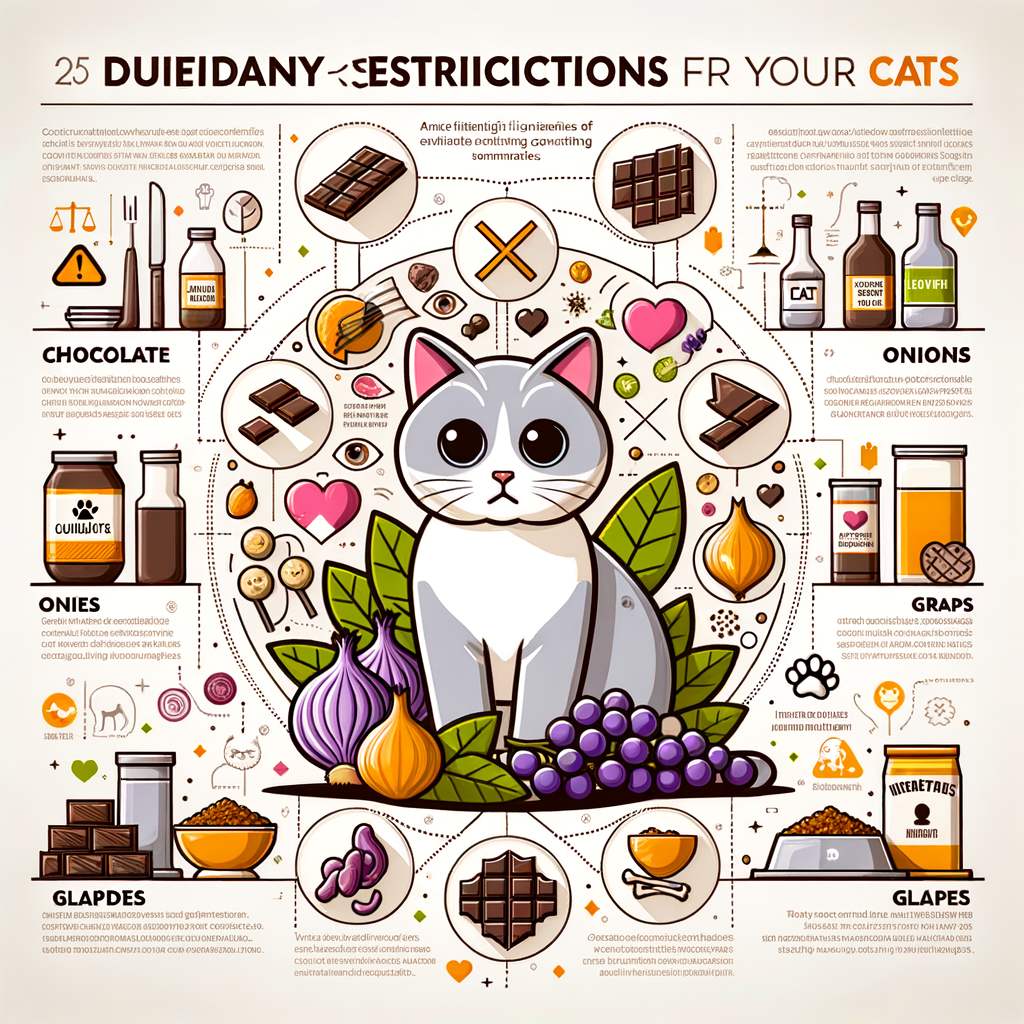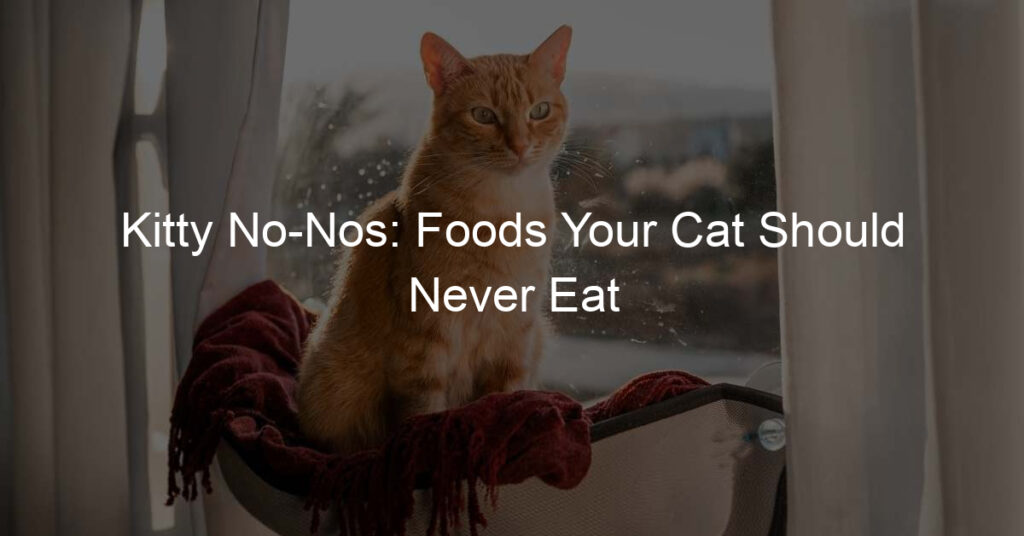
Introduction to Cat Food Restrictions
When it comes to feeding our feline friends, it’s crucial to understand that not all foods are safe or beneficial for them. Just like humans, cats require a balanced diet to stay healthy and active. However, there are some common misconceptions about what cats can and cannot eat. Let’s delve into these topics to ensure our cats are getting the best nutrition possible.
- Importance of a Balanced Diet for Cats
- Common Misconceptions about Feeding Cats
Cats are obligate carnivores, meaning they require a diet rich in meat. They need certain nutrients, like taurine, that are only found in animal tissues. A balanced diet for a cat includes proteins, fats, carbohydrates, vitamins, and minerals. This balance is crucial for their overall health and well-being. For instance, a diet lacking in taurine can lead to serious health problems like heart disease. Similarly, insufficient protein can result in weight loss and muscle wasting. Therefore, it’s essential to provide your cat with a well-rounded diet that meets all their nutritional needs.
There are several misconceptions about cat diets that can potentially harm your pet. One common myth is that cats should only eat fish. While fish can be a part of a cat’s diet, relying solely on it can lead to nutrient deficiencies. Another misconception is that cats can be vegetarian or vegan. As obligate carnivores, cats require nutrients found only in animal products, and a plant-based diet can lead to severe health issues. Lastly, many believe that cats should drink milk. However, most adult cats are lactose intolerant, and consuming dairy products can cause digestive problems. It’s important to dispel these myths to ensure our cats are fed correctly and healthily.
Foods Harmful to Cats
As a cat owner, it’s important to know what foods are safe for your feline friend to consume. While cats may seem interested in a variety of foods, not all are safe for them to eat. Some foods can cause serious health problems, or even be fatal. Let’s take a look at some of the most dangerous foods for cats.
Dangerous Foods for Cats: A Comprehensive List
Here is a list of foods that can be harmful to cats. It’s important to keep these items out of your cat’s reach and avoid feeding them to your pet.
- Onions and Garlic: Both onions and garlic contain compounds that can damage a cat’s red blood cells, leading to anemia. This is true for all forms of onions and garlic, including powdered, raw, cooked, and dehydrated.
- Chocolate: Chocolate is well-known to be harmful to dogs, but it’s also dangerous for cats. It contains theobromine, a substance that cats cannot metabolize effectively, leading to chocolate poisoning.
- Alcohol: Alcohol has the same effect on a cat’s liver and brain as it does on humans, but it takes far less to cause damage. Even a small amount can lead to serious health problems.
- Caffeine: Caffeine in large enough quantities can be fatal for cats, and there is no antidote. Symptoms of caffeine poisoning include restlessness, rapid breathing, heart palpitations, muscle tremors, and fits.
- Raw Dough: Raw dough can rise in a cat’s stomach causing pain and potentially rupturing the stomach or intestines.
- Raw Fish: Raw fish can contain bacteria that cause food poisoning. Additionally, an enzyme in raw fish destroys thiamine, an essential B vitamin for cats. A lack of thiamine can cause serious neurological problems and lead to convulsions and coma.
Remember, if you suspect your cat has eaten any of these foods, it’s important to contact your vet immediately. Prevention is always the best method, so keep these foods out of your cat’s reach.
Foods Cats Should Not Eat: The Details
As a cat owner, it’s crucial to know what foods are safe for your feline friend and which ones are not. In this section, we will delve into the details of why certain foods are harmful to cats.
Why These Foods are Unsafe for Cats
There are two main reasons why some foods are unsafe for cats. First, the chemical composition of these foods can be harmful. Second, these foods can have detrimental effects on a cat’s health. Let’s explore these reasons in more detail.
- Chemical Composition of Harmful Foods
- Effects of Toxic Foods on a Cat’s Health
Some foods contain chemicals that are toxic to cats. For example, onions and garlic contain a substance called thiosulphate, which can cause a condition called hemolytic anemia in cats. This condition breaks down a cat’s red blood cells, leading to weakness, breathlessness, and potentially life-threatening complications.
Consuming toxic foods can lead to a variety of health problems in cats. For instance, chocolate contains theobromine, a substance that can cause heart problems, seizures, and even death in cats. Similarly, alcohol and caffeine can cause nervous system damage in cats.
As a responsible cat owner, it’s important to be aware of these dangers and keep harmful foods out of your cat’s reach. In the next section, we will provide guidelines on how to feed your cat safely.
Cat Diet Guidelines: Feeding Cats Safely
Feeding your cat a balanced diet is essential for their health and well-being. Here are some guidelines to help you ensure your cat is getting the right nutrients without the risk of consuming harmful substances.
| Safe Foods | Unsafe Foods |
|---|---|
| Cooked fish and poultry | Raw fish and poultry |
| Certain fruits (apples, bananas) | Other fruits (grapes, raisins) |
| Certain vegetables (carrots, peas) | Other vegetables (onions, garlic) |
Remember, when in doubt, it’s always best to consult with your vet before introducing new foods into your cat’s diet.
Cat Diet Guidelines: Feeding Cats Safely
Feeding your feline friend safely is crucial to their health and well-being. Cats require a balanced diet, just like humans. However, not all human foods are safe for cats. Let’s explore some alternatives to harmful cat food ingredients.
Alternatives to Harmful Cat Food Ingredients
Many commercial cat foods contain ingredients that can be harmful to your cat’s health. Here are some safer alternatives that you can consider:
- Safe fruits and vegetables for cats
- Protein sources for cats
- Safe treats for cats
While cats are carnivores, certain fruits and vegetables can be a healthy addition to their diet. Apples, bananas, and blueberries are safe for cats and can provide essential vitamins and minerals. Vegetables like carrots, peas, and broccoli are also safe for cats. Remember to serve these in moderation and always remove any seeds or pits.
Cats require a high-protein diet. Chicken, turkey, and fish are excellent sources of protein for cats. Avoid feeding them raw meat as it can contain harmful bacteria. Cooked eggs are also a safe protein source. Always consult with your vet before making any significant changes to your cat’s diet.
Treats should make up no more than 10% of your cat’s daily caloric intake. Commercial cat treats, small pieces of chicken or fish, and cooked eggs can be safe treats for cats. Avoid feeding them anything with onions, garlic, chocolate, or caffeine as these can be toxic to cats.
Feeding your cat a balanced diet is essential for their overall health. Always consult with your vet before introducing new foods into your cat’s diet. Remember, what works for one cat may not work for another. Every cat is unique, and their dietary needs can vary.
Foods Toxic to Cats: Case Studies
Understanding the dangers of certain foods for cats is crucial for their health and well-being. Here, we will discuss real-life examples of cats who have suffered from the ingestion of toxic foods. These case studies will highlight the importance of keeping certain foods away from our feline friends.
Real-life Examples of Cats Affected by Unsafe Foods
Let’s delve into two specific cases that illustrate the serious consequences of feeding cats with harmful foods.
- Case study 1: Onion Poisoning
- Case study 2: Chocolate Toxicity
Meet Fluffy, a 3-year-old domestic cat. Fluffy’s owner, unaware of the dangers, gave her a small portion of onion to eat. Within a few hours, Fluffy became lethargic and lost her appetite. A visit to the vet confirmed that Fluffy was suffering from Heinz body anemia, a condition caused by onion toxicity in cats. The vet explained that onions contain a compound called N-propyl disulfide, which can damage a cat’s red blood cells, leading to anemia. Thankfully, Fluffy recovered after receiving prompt medical attention.
Next, we have Whiskers, a 5-year-old Siamese cat. Whiskers managed to sneak a few bites of a chocolate bar left on the coffee table. Soon after, Whiskers started to vomit and had diarrhea. The owner rushed Whiskers to the vet, where it was determined that he had chocolate toxicity. Chocolate contains theobromine, a substance that is toxic to cats. Whiskers was treated and, after a few days of care, was back to his playful self.
These case studies serve as a stark reminder of the dangers certain foods can pose to our beloved cats. It’s crucial to keep such foods out of their reach and to educate ourselves about what is safe for them to consume.
Conclusion: Avoid Feeding Cats Harmful Foods
In conclusion, it’s essential to understand the importance of feeding your cat the right foods. The health and wellbeing of your feline friend largely depend on their diet. As we’ve discussed, certain foods can be harmful or even fatal to cats. Therefore, it’s crucial to be aware of what you’re feeding them.
- Key takeaways
- Always check the ingredients of any food you plan to give your cat. If you’re unsure, consult a vet.
- Some foods, like chocolate, onions, and garlic, are toxic to cats and should be avoided at all costs.
- Even some common household foods, like milk and cheese, can be harmful to cats in large quantities.
- Always provide your cat with a balanced diet. This includes high-quality cat food and occasional treats.
- Final thoughts on feeding cats safely
Here are the main points to remember:
Feeding your cat safely is about more than just avoiding harmful foods. It’s about providing a balanced diet that meets all their nutritional needs. Remember, every cat is unique, and what works for one might not work for another. Always consult with a vet if you’re unsure about any aspect of your cat’s diet.
By following these guidelines, you can ensure that your cat lives a long, healthy, and happy life. Remember, your cat’s health is in your hands. Make the right choices when it comes to their diet, and they’ll thank you for it.








